Last updated: August 17, 2022
Article
Art in Culture: Latino Interns Explore Their Culture and Connection to Parks Through Art

NPS Photo
During the summer of 2022, thirty-three interns with the Latino Heritage Internship Program spent the summer working on projects at different National Park Service parks, offices, and programs across the country. As part of their internship, interns were asked to create artwork to expand the awareness and appreciation of Latino contributions to the United States. The interns were told to select a landscape, structure, or a historical figure of cultural significance to sketch or paint.
Eight interns decided to take the challenge and created some incredible art. Some of them found Latino connections in their sites and parks, others drew inspiration from special stories found at their sites, and others simply used their art skills to express how they connect to their park, culture, and heritage. Their artworks were presented at a Career and Leadership Workshop in Washington, DC, where interns were able to share the background of their creative inspiration.
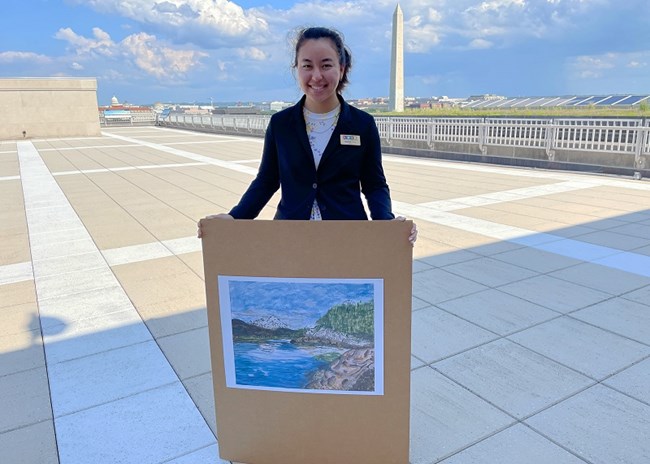
NPS Photo
Andrea Chow, Klondike Gold Rush National Historical Park
Andrea spent the summer in Alaska, far away from home, Southern California. She was an interpretation and education intern at Klondike Gold Rush National Historical Park. As an intern she helped develop educational outreach programs while trying to increase accessibility and engagement to underserved and underrepresented communities. One of her favorite parts was researching the intersections of environmental, economic, and migration histories during the Gold Rush era at Klondike. She chose to paint a view of Smuggler’s Cove from Yakutania Point in Skagway, Alaska, because of its connections with indigenous peoples and migrants.
“The towns of Skagway and Dyea mark the beginning of the Chilkoot Trail which was used historically for trade by indigenous groups to the region as well as for the Klondike Gold Rush. This small space holds a lot of important history of indigenous people and immigrants.”
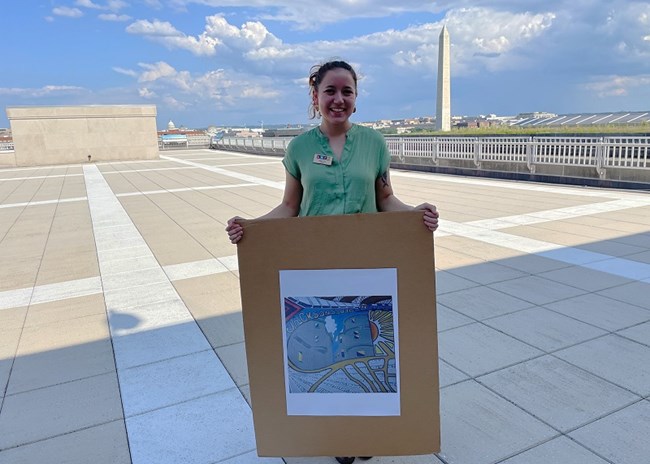
NPS Photo
Pia Cano, Olmsted Center for Landscape Preservation
Pia didn’t work at a park but instead worked at a program, as a Cultural Landscape Preservation Planning Assistant at Olmsted Center for Landscape Preservation. During their internship they focused in organizing, producing, and understanding significant sites and spaces of national heritage. Pia was staying near Boston, Massachusetts, and chose Jackson Square as their inspiration for their artwork. Jackson Square is a diverse neighborhood with a strong immigrant community, and it is known for its many Latino specialty shops, restaurants, and businesses.
“This project highlights Latinos in Boston and the sense of place they have created in Jackson Square. I wanted to incorporate an abstract representation of the footprint of their neighborhood, capturing what it is like to explore this space.”
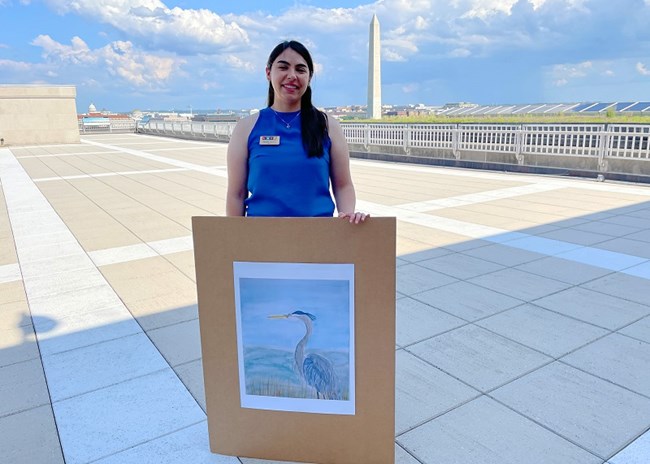
NPS Photo
Tatiana Mihaita, Congaree National Park
Tatiana was at Congaree National Park in South Carolina as a Forest Wellness Program intern. She helped create programs to help visitors increase their mental, physical, and emotional well-being. The park doesn’t have Latino roots or shared heritage, so at first, she didn’t know what to paint. In the end she decided to paint a beautiful great blue heron, her favorite bird, and the first bird she saw the first time she went to the park. Her artwork is not only an ode to her favorite bird, but also a commentary on immigration.
“Many birds are migratory species, going from one place to another, from continent to continent. And much like birds, people also migrate and move from place to place. So, in a way, we are connected to these beautiful creatures in more ways than you would expect.”
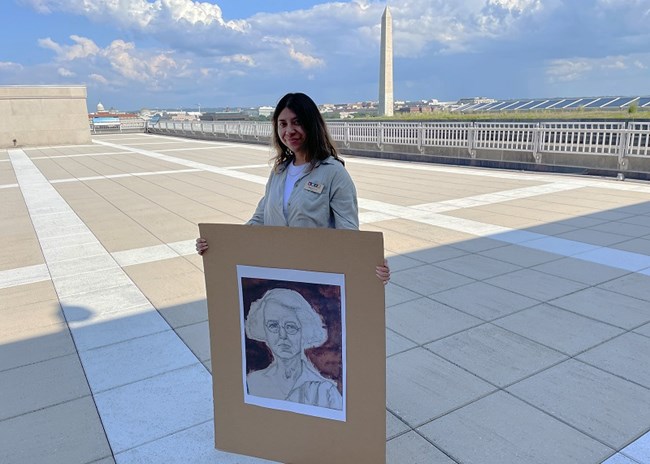
NPS Photo
Jhosselyn (Kiara) Prado-Albizures, Bering Land Bridge National Preserve
Kiara was yet another intern who was staying far from home, also in Alaska. She was a social media intern at Bering Land Bridge National Preserve, one of the nation's most remote national parks. During her internship she supported her park in their social media efforts and planning and coordinating the NPS Fashion Week. For her artwork she wanted to find a Latino historical figure that resonated with her and her work. While researching people she found out about Ynes Mexia, one of the most successful botanists and plant collectors, who was also a fierce conservationist and an early pioneer in fighting to preserve the redwood forests of Northern California.
“Ynes [Mexia] is the representation of the unique fabric that holds the ‘American Dream’ together. Because diverse narratives are imperative in order to accurately reflect the Latinx presence and contributions to America.”
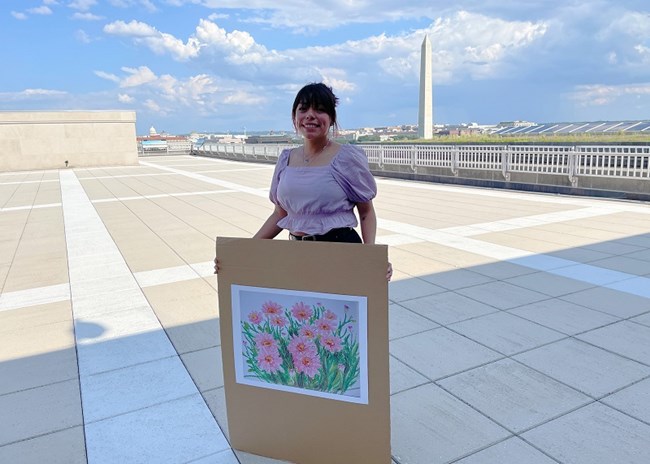
NPS Photo
Leslie Garcia, Salem Maritime and Saugus Iron Works National Historic Sites
Leslie was an interpretation intern at both Salem Maritime National Historic Site and Saugus Iron Works National Historic Site in Massachusetts. During her internship she supported park staff in researching, refining, and delivering bilingual interpretive and educational programs, and much more. A big part of her internship was trying to encourage diversity in the science field. Leslie drew inspiration for her painting from a colonial revival garden at Salem Maritime. As someone who is not only passionate about protecting the environment but also being outside in nature, she wants people to take time and connect with the outdoors.
“When life throws you into a hectic schedule, we need to remind ourselves to ‘stop and smell the flowers.’ Take a moment to enjoy the little things in life and the beauty and healing that nature brings us.”
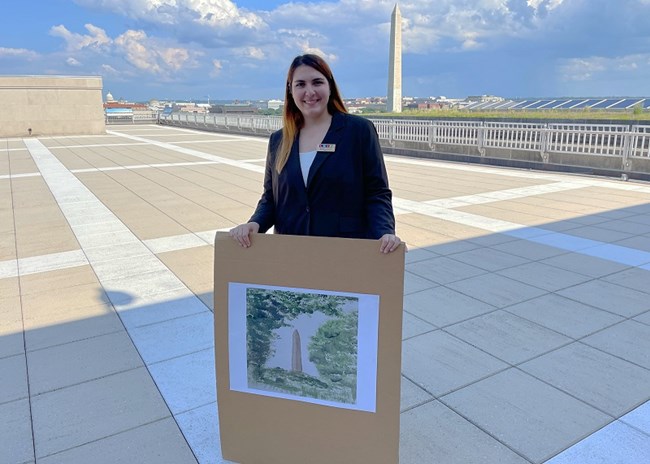
NPS Photo
Amie Sardinha, Historic American Buildings Survey Program
Amie’s internship took her to Washington, DC to work in the National Park Service headquarters inside the Department of the Interior building. She was an architectural intern and historic preservation technician with the Historic American Buildings Survey (HABS). During her internship, Amie documented the General Jose de San Martin Memorial in DC, while producing standard two-dimensional architectural drawings with some work in three-dimensional modeling. Her painting of the Washington Monument was inspired in her journey as a Latina in Washington, DC, during her internship.
“This is the view of the Washington Monument during my walks to the Department of the Interior every day. During my work, I found many references comparing Washington and General Jose de San Martin. So, it felt right to have a nod to the Latino Liberator in my art piece.”
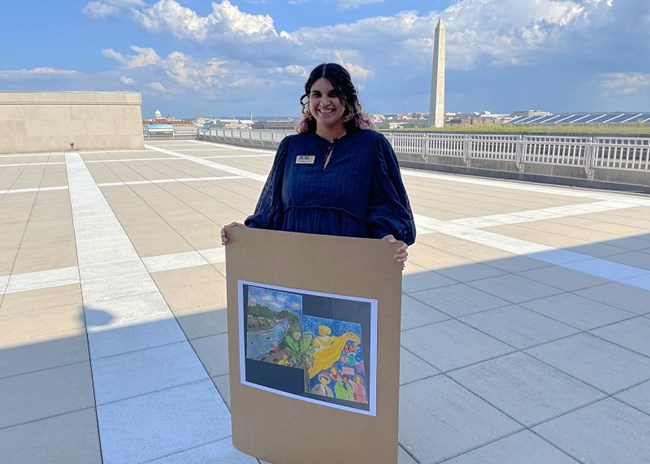
NPS Photo
Nayelie Morales, George Washington Memorial Parkway
Nayelie, who is from Puerto Rico, also spent her summer in Washington, DC, while working as a cultural landscape preservation intern at the George Washington Memorial Parkway. During her internship Nayelie helped collect data from the tree canopy at the George Washington Memorial Parkway, which will help develop future restoration projects. Nayelie painted two canvases and connected them. One represents the contributions of Latino communities to the park, and the other represents the impact of Latinos in the US. She also wanted to bring awareness of issues her island is facing.
“Minorities have always been fighting for their rights and equality. We still are. I wanted to showcase some of the many [Latino] activists that have made a powerful impact in history, like Sylvia Rivera. And I wanted to bring light to some of the economic, climate, and political issues Puerto Rico is still facing.”
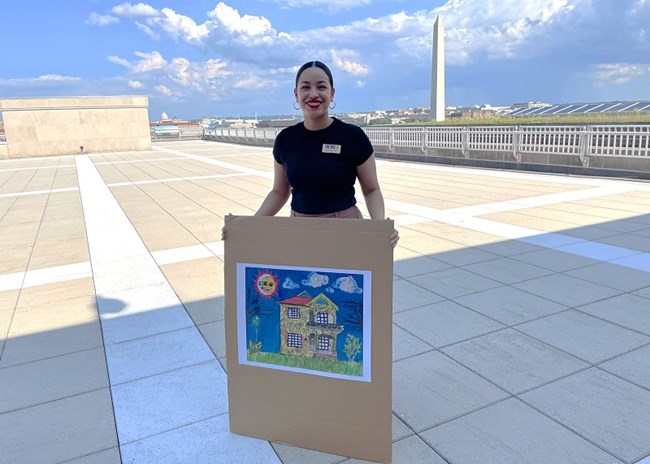
NPS Photo
Paola Vazquez, Rivers, Trails, and Conservation Assistance Program
Paola didn’t work at a park during her internship, but instead, she was a Latinx Partnership Outreach Coordinator at the Rivers, Trails, and Conservation Assistance Program (RTCA). Paola helped develop strategies for the Texas RTCA office, while focusing on increasing assistance and outreach to Spanish-speaking communities in Texas and Oklahoma. Paola painted the Briones House, referred to as “Casa de Sueños,” meaning “House of Dreams,” which is the largest and most prominent example of tinted concrete ornamentation on a building in the state of Texas, a style introduced from Mexico in the 1920s. It is also on the National Register of Historic Places.
“Mexican architecture is not highlighted enough even if you see it throughout the state. The Briones House, in the east Austin barrio, is a great highlight of Hispanic architecture in its decorative and colorful cement work.”
